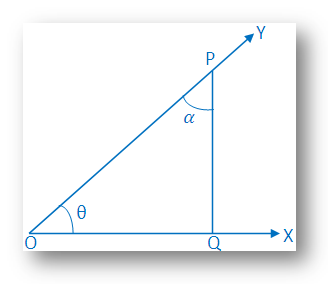Trigonometrical Ratios of Complementary Angles
How to find the trigonometrical ratios of complementary angles?
If the sum of two angles is one right angle or 90°, then one angle is said to be complementary of the other. Thus, 25° and 65°; θ° and (90 - θ)° are complementary to each other.
Suppose a rotating line rotates about O in the anti-clockwise sense and starting from its initial position
→OX traces out angle ∠XOY = θ, where θ is acute.
Take a point P on →OY and draw ¯PQ perpendicular to OX. Let, ∠OPQ = α. Then, we have,
α + θ = 90°
or, α = 90° - θ.
Therefore, θ and α are complementary to each other.
Now, by the definition of trigonometric ratio,
sin θ = ¯PQ¯OP; ………. (i)
cos θ = ¯OQ¯OP; ………. (ii)
tan θ = ¯PQ¯OQ ………. (iii)
And sin α = ¯OQ¯OP; ………. (iv)
cos α = ¯PQ¯OP; ………. (v)
tan α = ¯OQ¯PQ ….… (vi)
From (i) and (iv) we have,
sin α = cos θ
or, sin (90° - θ) = cos θ;
From (ii) and (v) we have,
cos α = sin θ
or, cos (90° - θ) = sin θ;
From (iii) and (vi) we have,
And tan α = 1/tan θ
or, tan (90° - θ) = cot θ.
Similarly, csc (90° - θ) = sec θ;
sec (90° - θ) = csc θ
and cot (90° - θ) = tan θ.
Therefore,
Sine of any angle = cosine of its complementary angle;
Cosine of any angle = sine of its complementary angle;
Tangent of any angle = cotangent of its complementary angle.
Corollary:
Complementary Angles: Two angles are said to be complementary if their sum is 90°. Thus θ and (90° - θ) are complementary angles.
|
(i) sin (90° - θ) = cos θ (iii) tan (90° - θ) = cot θ (v) sec (90° - θ) = csc θ |
(ii) cos (90° - θ) = sin θ (iv) cot (90° - θ) = tan θ (vi) csc (90° - θ) = sec θ |
We know there are six trigonometrical ratios in trigonometry. The above explanation will help us to find the trigonometrical ratios of complementary angles.
Worked-out problems on trigonometrical ratios of complementary angles:
1. Without using trigonometric tables, evaluate \frac{tan 65°}{cot 25°}
Solution:
\frac{tan 65°}{cot 25°}
= \frac{tan 65°}{cot (90° - 65°)}
= \frac{tan 65°}{tan 65°}, [Since cot (90° - θ) = tan θ]
= 1
2. Without using trigonometric tables, evaluate sin 35° sin 55° - cos 35° cos 55°
Solution:
sin 35° sin 55° - cos 35° cos 55°
= sin 35° sin (90° - 35°) - cos 35° cos (90° - 35°),
= sin 35° cos 35° - cos 35° sin 35°,
[Since sin (90° - θ) = cos θ and cos (90° - θ) = sin θ]
= sin 35° cos 35° - sin 35° cos 35°
= 0
3. If sec 5θ = csc (θ - 36°), where 5θ is an acute angle, find the value of θ.
Solution:
sec 5θ = csc (θ - 36°)
⇒ csc (90° - 5θ) = csc (θ - 36°), [Since sec θ = csc (90° - θ)]
⇒ (90° - 5θ) = (θ - 36°)
⇒ -5θ - θ = -36° - 90°
⇒ -6θ = -126°
⇒ θ = 21°, [Dividing both sides by -6]
Therefore, θ = 21°
4. Using trigonometrical ratios of complementary angles prove that tan 1° tan 2° tan 3° ......... tan 89° = 1
Solution:
tan 1° tan 2° tan 3° ...... tan 89°
= tan 1° tan 2° ...... tan 44° tan 45° tan 46° ...... tan 88° tan 89°
= (tan 1° ∙ tan 89°) (tan 2° ∙ tan 88°) ...... (tan 44° ∙ tan 46°) ∙ tan 45°
= {tan 1° ∙ tan (90° - 1°)} ∙ {tan 2° ∙ (tan 90° - 2°)} ...... {tan 44° ∙ tan (90° - 44°)} ∙ tan 45°
= (tan 1° ∙ cot 1°)(tan 2° ∙ cot 2°) ...... (tan 44° ∙ cot 44°) ∙ tan 45°, [Since tan (90° - θ) = cot θ]
= (1)(1) ...... (1) ∙ 1, [since tan θ ∙ cot θ = 1 and tan 45° = 1]
= 1
Therefore, tan 1° tan 2° tan 3° ...... tan 89° = 1
● Trigonometric Functions
- Basic Trigonometric Ratios and Their Names
- Restrictions of Trigonometrical Ratios
- Reciprocal Relations of Trigonometric Ratios
- Quotient Relations of Trigonometric Ratios
- Limit of Trigonometric Ratios
- Trigonometrical Identity
- Problems on Trigonometric Identities
- Elimination of Trigonometric Ratios
- Eliminate Theta between the equations
- Problems on Eliminate Theta
- Trig Ratio Problems
- Proving Trigonometric Ratios
- Trig Ratios Proving Problems
- Verify Trigonometric Identities
- Trigonometrical Ratios of 0°
- Trigonometrical Ratios of 30°
- Trigonometrical Ratios of 45°
- Trigonometrical Ratios of 60°
- Trigonometrical Ratios of 90°
- Trigonometrical Ratios Table
- Problems on Trigonometric Ratio of Standard Angle
- Trigonometrical Ratios of Complementary Angles
- Rules of Trigonometric Signs
- Signs of Trigonometrical Ratios
- All Sin Tan Cos Rule
- Trigonometrical Ratios of (- θ)
- Trigonometrical Ratios of (90° + θ)
- Trigonometrical Ratios of (90° - θ)
- Trigonometrical Ratios of (180° + θ)
- Trigonometrical Ratios of (180° - θ)
- Trigonometrical Ratios of (270° + θ)
- Trigonometrical Ratios of (270° - θ)
- Trigonometrical Ratios of (360° + θ)
- Trigonometrical Ratios of (360° - θ)
- Trigonometrical Ratios of any Angle
- Trigonometrical Ratios of some Particular Angles
- Trigonometric Ratios of an Angle
- Trigonometric Functions of any Angles
- Problems on Trigonometric Ratios of an Angle
- Problems on Signs of Trigonometrical Ratios
11 and 12 Grade Math
From Trigonometrical Ratios of Complementary Angles to HOME PAGE
Didn't find what you were looking for? Or want to know more information about Math Only Math. Use this Google Search to find what you need.
Recent Articles
-
Counting Numbers from 1 to 50 | Match the Number | Missing Numbers
Apr 04, 25 03:46 PM
In counting numbers from 1 to 50, recognize the numbers, count and then join the numbers in the correct number order. Here we mainly need eye-hand coordination to draw the picture and maintain the num -
Counting Eleven to Twenty with Numbers and Words |Numbers from 11 - 20
Apr 04, 25 03:21 PM
Counting eleven to twenty with numbers and words are explained below. One ten and one more is eleven. Eleven comes after ten. One ten and two more is twelve. Twelve comes after eleven. -
5th Grade BODMAS Rule Worksheet | PEMDAS | Order of operations|Answers
Apr 03, 25 03:11 PM
In 5th Grade BODMAS Rule Worksheet you will get different types of problems on mathematical expressions involving different operations, mathematical expression with 'brackets' and 'of' and simplifying… -
Worksheet on Simplification | Simplify Expressions | BODMAS Questions
Apr 03, 25 02:58 PM
In worksheet on simplification, the questions are based in order to simplify expressions involving more than one bracket by using the steps of removal of brackets. This exercise sheet -
Divisible by 2 Video |Test of Divisibility by 2 Trick| Rules| Examples
Apr 03, 25 10:25 AM
A number is divisible by 2 if the digit at unit place is either 0 or multiple of 2. So a number is divisible by 2 if digit at its units place is 0, 2, 4, 6 or 8.






New! Comments
Have your say about what you just read! Leave me a comment in the box below. Ask a Question or Answer a Question.